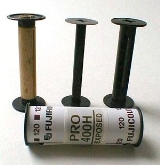
120 film
Overview
Film format
A film format is a technical definition of a set of standard characteristics regarding image capture on photographic film, for either stills or movies. It can also apply to projected film, either slides or movies. The primary characteristic of a film format is its size and shape.In the case of...
for still photography
Photography
Photography is the art, science and practice of creating durable images by recording light or other electromagnetic radiation, either electronically by means of an image sensor or chemically by means of a light-sensitive material such as photographic film...
introduced by Kodak for their Brownie
Brownie (camera)
Brownie is the name of a long-running and extremely popular series of simple and inexpensive cameras made by Eastman Kodak. The Brownie popularized low-cost photography and introduced the concept of the snapshot. The first Brownie, introduced in February, 1900, was a very basic cardboard box camera...
No. 2 in 1901. It was originally intended for amateur photography but was later superseded in this role by 135 film
135 film
The term 135 was introduced by Kodak in 1934 as a designation for cartridge film wide, specifically for still photography. It quickly grew in popularity, surpassing 120 film by the late 1960s to become the most popular photographic film format...
. Along with its close relative, 220 film, 120 film survives to this day as the only medium format films that are readily available to both professionals and amateur enthusiasts.
The 120 format is typical of roll film
Roll film
Rollfilm or roll film is any type of spool-wound photographic film protected from white light exposure by a paper backing, as opposed to film which is protected from exposure and wound forward in a cartridge. Confusingly, roll film was originally often referred to as "cartridge" film because of its...
.

